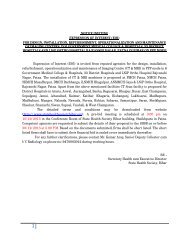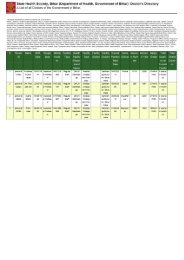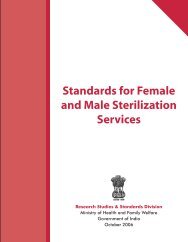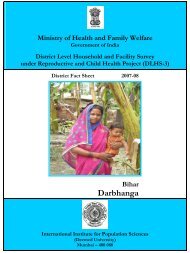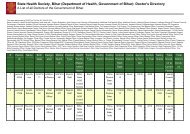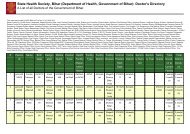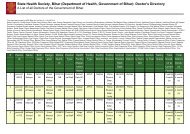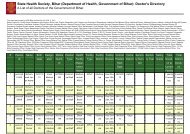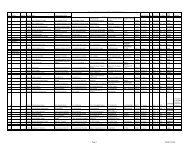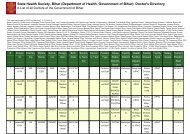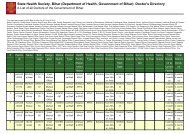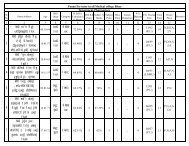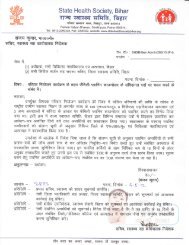District Health Action Plan - STATE HEALTH SOCIETY-----BIHAR
District Health Action Plan - STATE HEALTH SOCIETY-----BIHAR
District Health Action Plan - STATE HEALTH SOCIETY-----BIHAR
Create successful ePaper yourself
Turn your PDF publications into a flip-book with our unique Google optimized e-Paper software.
system, infect the liver and red blood cells, and finally develop into a form that is able to<br />
infect a mosquito again when it bites an infected person. Inside the mosquito, the parasite<br />
matures until it reaches the sexual stage where it can again infect a human host when the<br />
mosquito takes her next blood meal, 10 to 14 or more days later.<br />
Malaria symptoms appear about 9 to 14 days after the infectious mosquito bite, although this<br />
varies with different plasmodium species. Typically, malaria produces fever, headache,<br />
vomiting and other flu-like symptoms. If drugs are not available for treatment or the parasites<br />
are resistant to them, the infection can progress rapidly to become life-threatening. Malaria<br />
can kill by infecting and destroying red blood cells (anaemia) and by clogging the capillaries<br />
that carry blood to the brain (cerebral malaria) or other vital organs.<br />
Malaria, together with HIV/AIDS and TB, is one of the major public health challenges<br />
undermining development in the poorest countries in the world.<br />
Goal- To reduce mortality and morbidity due to Malaria<br />
B.3.2 Kala-Azar<br />
Kala azar (Visceral Leishmaniasis ) is a deadly disease caused by parasitic protozoa<br />
Leishmania donovani, transmitted to humans by the bite of infected female sandfly,<br />
Phlebotomus argentipes. It lowers immunity, causes persistant fever, anemia, liver and spleen<br />
enlargement, and if left untreated, it kills. The vector thrives in cracks and crevices of mud<br />
plastered houses, poor housing conditions, heaps of cow dung, in rat burrows, in bushes and<br />
vegetations around the houses.<br />
Saran is a Kala-azar prone area in the State. Studies reveals that the ST and SC community<br />
especially Mushhar community are vulnerable towards the epidemic due to their poor living<br />
conditions<br />
102 | P a g e D i s t r i c t H e a l t h A c t i o n P l a n 2 0 1 2 - 1 3 D H S , S a r a n



